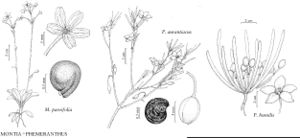Phemeranthus
Specchio Sci. 1: 86. 1814.
Herbs, perennial, caulescent (subscapose in P. humilis), glabrous. Roots sometimes tuberous, fleshy to woody. Stems ascending to erect, simple or branching, sometimes suffrutescent. Leaves alternate or subopposite, sometimes subrosulate, petiolate or sessile, articulate at base, not clasping but sometimes with auriculate, membranous to chartaceous basal enations, attachment point round; blade terete, semiterete, or narrowly planate, 1–3 (10–20 in P. aurantiacus) mm wide, succulent (semisucculent in P. aurantiacus, P. sediformis, and P. spinescens). Inflorescences lateral and/or terminal (lateral sometimes appearing terminal due to congestion of leaves on very short stems), cymose or cymulose, not appearing secund, few to many-flowered, or flowers solitary and axillary; peduncle very short-to-elongate, sometimes scapelike. Flowers pedicellate (sometimes subsessile or sessile in P. parviflorus), each opening for 2–4 hours from afternoon to early evening of a single day, sometimes facultatively cleistogamous; sepals promptly deciduous after anthesis or persistent through capsule development, distinct; petals fugacious, 5 or rarely more, distinct or sometimes basally connate; stamens 4–many, distinct or with filaments basally shortly coherent in several clusters, anther 2-locular, oblong (subglobose in P. rugospermus); gynoecium 3 [–5] -carpelled, placentention free-central; style 1 [absent]; stigmas 1 or 3 [–5]. Capsules longitudinally dehiscent from apex, 3-valved; valves deciduous, erect, exocarp and endocarp not evidently differentiated and not separating. Seeds many, black or brown, ± compressed, with or without ± parallel, arcuate ridges, estrophiolate, circular-reniform, small; seed-coat lustrous, smooth (corrugate-rugulose in P. rugospermus), covered with pale white or gray, thin, dull, fleshy to chartaceous pellicle. x = 12.
Distribution
North America, Central America, South America
Discussion
Species 25–30 (16 in the flora).
C. S. Rafinesque (1814b) transferred Pursh’s Talinum teretifolium, which had been described earlier that year and was the only North American species then attributed to that primarily Old World genus, to the segregate genus Phemeranthus. Since then, though, most other authors have continued to recognize that species within Talinum, along with other similar and exclusively New World taxa described subsequently, as sect. Phemeranthus. However, a fairly strongly correlated set of differences in the leaf, pollen, fruit, and seed structures of these species compared with those of sect. Talinum, only two species of which are found in North America, supports their recognition at the generic level (R. Carolin 1987, 1993; M. A. Hershkovitz 1993). Complementary to the morphological evidence, recent molecular studies (M. A. Hershkovitz and E. A. Zimmer 1997, 2000; W. L. Applequist and R. S. Wallace 2001) indicate that Phemeranthus is phylogenetically distinct from Talinum.
Positive identification of Phemeranthus specimens often requires examination of both flower and fruit, including seeds (with hand lens). Fortunately, the flowers develop successively and the capsules mature rapidly after anthesis, so both flowers and fruits will be present on a given plant during most of the reproductive season.
Selected References
Lower Taxa
Key
| 1 | Petals yellow, orange, or reddish or pinkish orange | > 2 |
| 1 | Petals white, pink, or purplish (sometimes tinged pale yellow in P. sediformis) | > 4 |
| 2 | Flowers usually solitary, sometimes 2-3-flowered cymules in leaf axils | Phemeranthus aurantiacus |
| 2 | Flowers in cymes borne on scapelike peduncles | > 3 |
| 3 | Leaves sessile, not appearing petiolate | Phemeranthus humilis |
| 3 | Leaves sessile but appearing petiolate | Phemeranthus marginatus |
| 4 | Seeds with arcuate ridges | Phemeranthus longipes |
| 4 | Seeds without arcuate ridges | > 5 |
| 5 | Seeds corrugate-rugulose | Phemeranthus rugospermus |
| 5 | Seeds smooth | > 6 |
| 6 | Stamens usually 5 | Phemeranthus parviflorus |
| 6 | Stamens usually 7 or more | > 7 |
| 7 | Stigmas 3 | Phemeranthus brevifolius |
| 7 | Stigma 1 | > 8 |
| 8 | Stems bearing persistent midribs of old leaves | > 9 |
| 8 | Stems not bearing persistent midribs of old leaves | > 10 |
| 9 | Persistent midribs ± straight, spinelike, 5 mm or more | Phemeranthus spinescens |
| 9 | Persistent midribs arcuate, bristlelike, less than 5 mm | Phemeranthus sediformis |
| 10 | Sepals deciduous after anthesis | > 11 |
| 10 | Sepals persistent through capsule development | > 12 |
| 11 | Petals 9-15 mm; stamens 40 or more | Phemeranthus mengesii |
| 11 | Petals 5-7 mm; stamens 12-20 | Phemeranthus teretifolius |
| 12 | Stamens fewer than 20 | > 13 |
| 12 | Stamens usually 20 or more | > 14 |
| 13 | Peduncles 1 cm or shorter; capsules ellipsoid | Phemeranthus thompsonii |
| 13 | Peduncles longer than 1 cm; capsules ovoid | Phemeranthus validulus |
| 14 | Peduncles not scapelike, shorter than 2 cm | Phemeranthus brevicaulis |
| 14 | Peduncles scapelike, much longer than 2 cm | > 15 |
| 15 | Sepals 3-4 mm; petals 8-10 mm | Phemeranthus calcaricus |
| 15 | Sepals 4-6 mm; petals 10-15 mm | Phemeranthus calycinus |

